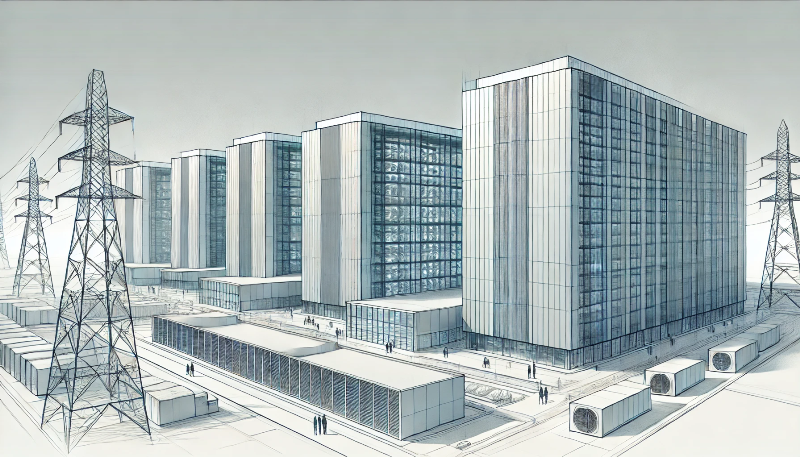BELLEVUE, Wash., June 17, 2024 /PRNewswire/ — Evergreen Home Loans, a full-service direct home loan lender offering origination, funding, and servicing in the Western U.S., announced t...
The Data Center Gold Rush: How Real Estate Giants Are Betting Big on Digital Infrastructure




In a bold move that signals a seismic shift in commercial real estate, logistics giant Prologis announced plans to develop 10 gigawatts of data center capacity over the next decade. This ambitious strategy is not an isolated play—it reflects a broader transformation sweeping through the real estate sector as traditional property developers pivot to meet the explosive demand for digital infrastructure.
Newmark’s latest market analysis projects that the data center industry will double in size by 2030, attracting both established real estate players and new entrants eager to capitalize on the sector’s rapid expansion. The ripple effects of this shift extend far beyond data centers themselves, reshaping investment strategies and market dynamics across industrial, office, and retail real estate.
The Race for Land and the Industrial Real Estate Evolution
The competition for prime data center locations has intensified, with developers locked in bidding wars over strategic sites. In Genesee County, New York, three developers are vying for position at the STAMP site, where multi-billion-dollar projects are on the table. Similarly, in Buckeye, Arizona, developers recently closed a $136 million land acquisition for 2,069 acres, planning a $20 billion data center park.
For the industrial sector, this transformation signals a shift in how land is valued. Traditionally, industrial real estate has been driven by logistics hubs, warehouse demand, and manufacturing needs. Now, land with abundant power resources and fiber connectivity is commanding premium prices. Industrial developers who previously focused on traditional logistics assets must now consider whether their properties could be repurposed or integrated with digital infrastructure. The growing importance of edge computing, which brings processing power closer to end users, could further boost demand for industrial spaces that can be converted into smaller-scale data hubs.
Office Real Estate: A Potential Lifeline in Adaptive Reuse?
As remote and hybrid work models continue to disrupt the office sector, struggling office landlords are seeking new strategies to revitalize their portfolios. Data centers offer an intriguing possibility—particularly for well-located but underutilized office properties. The adaptive reuse of existing buildings could become a key trend, especially in markets where commercial real estate values have dipped significantly.
However, repurposing office buildings into data centers is not without challenges. Power infrastructure, cooling requirements, and structural modifications present significant hurdles. Still, office landlords willing to invest in conversions may find themselves at the forefront of a lucrative transition. As artificial intelligence and cloud computing drive increased data processing needs, there will be opportunities for creative redevelopment in urban and suburban office corridors.
Retail Real Estate and the Edge Computing Boom
Retail real estate, which has undergone significant upheaval in the past decade, is also being reshaped by the digital infrastructure surge. As e-commerce continues to dominate, former big-box stores and shopping malls have become prime candidates for conversion into data centers or edge computing facilities.
Secondary markets are particularly poised for this shift. With the rise of edge computing, smaller-scale data facilities are being developed closer to population centers to reduce latency. This trend aligns with the growing number of vacant retail spaces that offer ample square footage, strong infrastructure, and proximity to consumers. Developers who understand this intersection between retail real estate and digital infrastructure will be well-positioned to capitalize on emerging opportunities.
Capital Markets and the Changing Investment Landscape
Institutional investors have taken notice. Real Estate Investment Trusts (REITs) are increasingly allocating capital to data center infrastructure, recognizing its stable income characteristics and high growth potential. This transition marks a significant evolution from traditional commercial real estate investments, where retail and office assets once dominated investor portfolios.
At the same time, sustainability and energy efficiency are emerging as critical considerations. With concerns over the environmental impact of large-scale data centers, developers and investors are placing greater emphasis on renewable energy integration and green building practices. The ability to secure and manage power infrastructure will be a key differentiator in the success of future projects.
Financing Structures: Capital Markets and Investment Approaches
As data centers straddle the line between real estate and technology investments, financing structures are evolving to accommodate the hybrid nature of these assets. Traditional real estate financing models—such as mortgage-backed loans and equity investments—are being adapted to fit the capital-intensive requirements of data center development.
Private equity firms and infrastructure funds are increasingly investing in data centers through joint ventures, recognizing the long-term value of these high-demand assets. Real Estate Investment Trusts (REITs), particularly those specializing in digital infrastructure, are aggressively expanding their portfolios, offering investors a way to gain exposure to the sector without direct ownership.
Debt financing for data centers has also evolved, with lenders placing a heightened emphasis on power procurement strategies and long-term tenant commitments. Given the energy-intensive nature of data centers, financing models now often incorporate sustainability-linked loans that incentivize developers to integrate renewable energy sources and improve energy efficiency. The ability to structure financing in a way that balances capital expenditure with operational sustainability will be a key determinant of success in this evolving market.
Looking Ahead: Navigating a New Real Estate Landscape
The future of commercial real estate is increasingly intertwined with digital infrastructure. While the rapid expansion of data centers presents substantial opportunities, it also comes with risks. Some market observers, including DeepSeek, have urged caution, citing potential overdevelopment and power supply constraints. Local communities, too, are grappling with the implications of large-scale projects, as seen in Alabama, where residents recently gathered to discuss the impact of new developments.
For real estate professionals, success in this evolving market requires a nuanced understanding of both traditional real estate fundamentals and the technical requirements of digital infrastructure. Industrial developers must assess the viability of their land for high-power applications, office landlords should explore adaptive reuse strategies, and retail owners can leverage vacant properties for edge computing expansions.
The digital infrastructure gold rush is not just a passing trend—it is a structural transformation reshaping the industry. Those who adapt to this shift, integrating sustainability, technology, and strategic site selection into their approach, will be best positioned to thrive in the next era of commercial real estate.
This article was developed based on market research and industry announcements from Q1 2025. Key sources include announcements from Prologis, Tract, and Newmark, as well as local development news from Genesee County, NY, Chesterfield County, VA, and Buckeye, AZ.
Similar Articles
Explore similar articles from Our Team of Experts.


“Multifamily developments need parking to satisfy their rental tenants and condominium owners needs and expectations of being able to park and store their vehicles where they live,R...


Boca Raton, FL, July 09, 2024 (GLOBE NEWSWIRE) — Janover Inc. (Nasdaq: JNVR) (“Janover” or the “Company”), an AI-enabled platform for commercial real estate transactions, tod...


Award positions Premier’s executive amongst Dallas’ top business leaders. DALLAS, TEXAS, UNITED STATES, August 27, 2024 /EINPresswire.com/ — Recently, Dallas Business Journal, one ...


New 10 Year Commitment Investment Fund to Drive Inclusive Innovation and Empower Underrepresented Entrepreneurs Today marks the launch of something extraordinary–a fund that seeks to inves...




